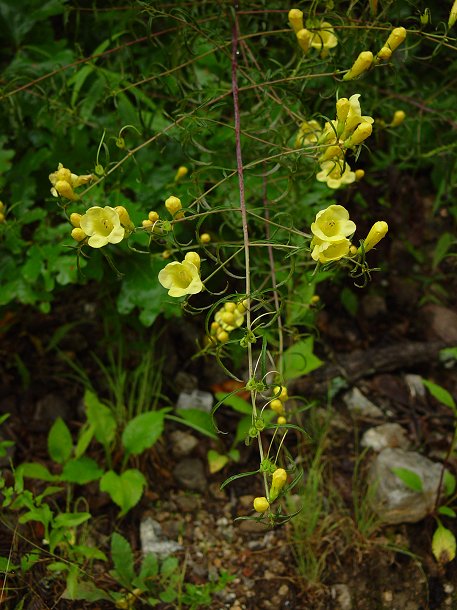Aureolaria flava (L.) Farw.
Smooth False Foxglove

Native
CC = 8
CW = 5
MOC = 24
© DETenaglia
Aureolaria flava (L.) Farw.Smooth False Foxglove | |
 |
Native CC = 8 CW = 5 MOC = 24 |
© DETenaglia |
|
Family - Orobanchaceae Habit - Perennial, hemiparasitic forb. Stems - Arching, ascending, or erect, 50-150 cm long, glabrous, usually somewhat glaucous, often branched, often purplish tinged, fistulose.
Leaves - Opposite, decussate, 6-15 cm long, deeply pinnatifid, becoming linear near the apex, the lobes linear to narrowly elliptic or narrowly lanceolate, the margins otherwise entire or few-toothed, the upper surface deep green, moderately roughened with minute, stiff, broad-based, nonglandular hairs, the undersurface lighter green, sparsely roughened to glabrous, easily broken or damaged, sub-succulent.
Inflorescence - Open, terminal racemes with leafy bracts, the flowers paired at the nodes, usually appearing as axillary flowers toward the stem tip, variously short-stalked to moderately long-stalked, the stalks somewhat thickened toward the tips, lacking bractlets, glabrous. Cleistogamous flowers absent.
Flowers - Calyces 9-16 mm long, bell-shaped and somewhat zygomorphic, glabrous, 5-lobed, the lobes shorter than to slightly longer than the tube, linear, entire. Corollas 35-60 mm long, 5-lobed, bell-shaped, glabrous externally, pubescent at the base internally. Corolla lobes rounded, spreading, glabrous except along the margins. Stamens 4, didynamous, fused to the base of the corolla tube, slightly exserted. Filaments yellow, to 3 cm long, with a single vertical strip of curly yellow pubescence. Anthers to 7 mm long, spurred at the base. Ovary superior, surrounded by a dark green nectary ring, somewhat compressed, glabrous. Style glabrous, greenish, 4 cm long.
Fruits - Capsules 12-20 mm long, ovoid, glabrous. Seeds 1.7-2.7 mm long, with coarse, winglike ridges.
Flowering - June - September. Habitat - Upland forests, borders of glades, fens, sinkhole ponds. Origin - Native to the U.S. Lookalikes - The flowers of this species are very similar to those of the two other members of the genus found in Missouri, but foliar characters provide easy differentiation. The species on this page is the only one with stems which are glabrous and smooth, and often glaucous. Other info. - This striking species can be found mostly in the southeastern third of Missouri, and across most of the eastern third of the continental U.S. The plant is fairly common in the habitats mentioned above and can be very showy when in flower. The species has been further subdivided, but Missouri material does not conform well to these divisions, with a lack of correlation of the character states used for differentiation. The generic taxonomy is in need of further study and revision. Photographs at the Peck Ranch Conservation Area, Carter County, MO., 7-12-03 (DETenaglia); also at Taum Sauk State Park, Iron County, MO, 7-11-2013 and 8-4-2020 (SRTurner). |